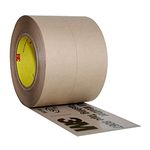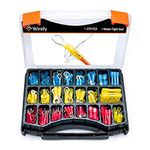Shop vacuums and sparks are a dangerous combination
In the latest issue (FHB #169, “Tips & Techniques,” p. 30), David Crosby suggests using a shop vacuum while grinding tile and plaster. Personal experience has demonstrated that grinding anything that can create sparks when using a vacuum with sawdust in it can produce a very impressive conflagration in an astoundingly short period of time.
In my case, I was able to get the vac outside by pulling it with the cord before the fire spread to the low ceiling, which was the floor of our den. The same could happen using a masonry cutoff blade in a tablesaw with sawdust packed in the body. Again, personal experience. In short: Clean your shop vacuum!
—Michael Vickery, via email
Subfloor panel is radiant-heating system
As longtime readers and advertisers, we were pleased to see Rick Arnold’s article “Warm Floors Now Easier Than Ever” in your December/January issue (FHB #168, pp. 52-57). As more and more consumers switch to radiant, it is increasingly important to give them all the information they need when choosing to put radiant heat in their new home or addition. Although Rick’s article was well written and informative, there are several technical inaccuracies.
First, he mentions our product, Warmboard Radiant Subfloor, in conjunction with “similar” on-top-of-the-subfloor systems. Warmboard is not an on-top-of-the-subfloor system; it is the subfloor. In fact, Warmboard is the only radiant-heat product that is a structural subfloor and radiant panel in one, making installation more streamlined and cost-effective. Second, he mentions that two drawbacks of radiant heat are slow response time and incompatibility with wall-to-wall carpet. With Warmboard, neither statement is accurate. Because Warmboard uses aluminum in a patented way to conduct heat, our panels have an amazingly fast response time and adapt to any floor covering, including wall-to-wall carpet, without compromising efficiency.
—Terry Alsberg, CEO, Warmboard Inc.
Rick Arnold replies: Clearly, Warmboard belongs in a category by itself. And while I haven’t used it yet, I could believe Warmboard’s response time might be faster than staple-up systems or on-top-of-the-subfloor panels. However, I still doubt it would be as quick as either forced hot-air or forced hot-water baseboard heat.
As far as wall-to-wall carpet goes, I stand by what I said: that it will make a radiant-floor heating system less efficient. When you increase the R-value (carpets, padding, etc.) over any in-floor radiant system, especially those over unconditioned space, more heat is lost in the wrong direction, thereby requiring hotter water to maintain the room temperature.
Get the foundation drain in the right place
In your article “The No-Mold Finished Basement” (FHB #169, pp. 78-83), the drawing on p. 79 shows the bottom of the foundation drainpipe above the grade of the finished concrete floor. In soils with a high silt or clay content, that basement would be wet because the water level has to get as high as the bottom of the perforated drainpipe before it exits the crushed-stone well created in the soil surrounding the foundation. We always put our drainpipe at the bottom of the footing to prevent seepage from the joints in the concrete. Also, after the exterior of the foundation has been waterproofed, we put filter fabric only on the top and on the side of the crushed stone because it will most likely be contaminated from backfill sand washing vertically down from above rather than from the hard-packed surface below.
—Lonn. M. Livengood, via email
No fumes from water-based contact cement
Regarding the tip about gluing up laminate counters with exterior yellow glue (FHB #169, p. 30), I have a better suggestion. If you don’t like the fumes from solvent-based contact cement (and who does?), why not use a product designed for laminate installation?
I use a water-based contact cement. It dries almost as fast as the nasty stuff, smells similar to latex paint, and has a lower VOC than paint. I’ve used it exclusively for at least 15 years, on both residential and commercial jobs, and never had a callback. The brand I use is Wilsonart (www.wilsonart.com), but I know there are others available.
—George Buehler, Pocatello, Idaho
Home elevators can be even bigger
In his article “Home Elevators” (FHB #169, pp. 84-87), Gary Striegler suggests that residential elevators are limited in size to 15 sq. ft. I recently had occasion to look into the elevator-car size limit in the American Society of Mechanical Engineers (ASME) A17.1, Section 5.3.1.10.1, Capacity of Private Residence Electric Elevators. According to the ASME staff, the 15-sq.-ft. car-size limit in this section of the standard is meant to define the scope of this part of the standard, not to set an absolute limit on elevator-car size in private residences. ASME does not prohibit the use of larger car sizes in private residences, but elevator installation and maintenance in such a case would be controlled by other applicable sections of ASME A17.1.
In North Carolina, the Department of Labor enforces elevator-safety standards statewide, and that agency chooses not to inspect elevators in private residences at all. However, because ASME A17.1 is recognized as the standard for elevators nationwide, installing an elevator of any kind in the United States without learning the standard and complying with it would leave a builder open to the kind of legal challenge that we all try very hard to avoid.
Many of us have learned the hard way the downside of accepting hearsay information about limitations established by codes and standards, especially when they run afoul of a demanding client’s wish list. If you’re going to tell your client it can’t be done, it’s wise to operate on completely reliable information. For more on ASME’s elevator standards, go to www.asme.org.
—Leon Meyers, Durham, N.C.
Ungrounded GFCIs must be labeled
In the February/ March issue, Clifford A. Popejoy’s article “Is Your Old Wiring Safe?” (FHB #169, pp. 74-77) omits an important detail regarding retrofitting GFCIs to ungrounded circuits. Per the NEC, you also need to apply the “No Equipment Ground” stickers, usually supplied with the GFCI. The same applies for any three-prong outlets hooked to the “load” side of the GFCI, if applicable.
—Chris Patstone, via email
Clifford A. Popejoy replies: You’re right. A GFCI-receptacle outlet that is not connected to an equipment ground should be labeled. This requirement is found in section 406.3(D)(3) of the 2005 National Electrical Code (NEC). Because the article’s focus was not installation of GFCIs and because a GFCI receptacle comes with installation instructions (and most come with the required labels), I figured I didn’t need to make the point. But it’s a good one.
Storage behind stoves is not a good idea
Sam Clark’s “Drawing Board” column, “Function: the first priority of kitchen storage,” emphasizes the importance of margin-area storage (FHB #168, pp. 132, 134, 136). The drawing on p. 136 is creative but flawed. Storage is located behind the cooktop, and the cooktop is not vented. Even if it were vented correctly (in many locales, venting is a building-code requirement), this area will get greasy from cooking spatters. It is also a burn hazard to reach across hot burners to retrieve an item. Adjacent cabinets, left and right of the cooktop, if placed 15 in. or less from the counter may get scorched from the burners.
To make this idea work, I would suggest a heatproof surface behind the cooktop extending at least 3 in. left and right on each side. This surface could be stone, stainless steel, or decorative tile. The remaining margin-area storage is useful, sensible, and safe.
—Bob Lidsky, Andes, N.Y.
Sam Clark replies: You are correct. It is better if margin storage doesn’t go behind the cooktop. We should have chosen a better illustration.
However, I would dispute the point that a vent or a hood is always needed. Some jurisdictions may require them, commercial-stylestovesdoneed them, and they often are useful. But if you don’t cook a lot of meat or other greasy foods, or if you aren’t particularly sensitive to smells, a hood may be of little use. And of course, many are installed but never used. I always go over the options with my clients before including them.
Does radiant heat work with bamboo flooring?
I found Rick Arnold’s article “Warm Floors Now Easier Than Ever” (FHB #168, pp. 52-57) very helpful because I am considering hydronic-radiant heat in my next home. I especially appreciated the sidebar, “The right wood floor over radiant heat,” as this is an issue my wife and I are researching.
What thickness of bamboo flooring did Mr. Arnold install? I’m concerned about the heat transmittance of the dense bamboo flooring.
—Ken King, via email
Rick Arnold replies: For the project featured in the article, I used prefinished 5⁄8-in.-thick bamboo, which I purchased from a national retailer called Lumber Liquidators (800-356-6746; www.lumberliquidators.com). It goes down with the same nailers used for 3⁄4-in. stock. In my own house, I used their prefinished 3⁄4-in. Bolivian rosewood, which is even harder and more dense than bamboo, and it’s performing very well with the radiant-floor heat.
Fine Homebuilding Recommended Products
Fine Homebuilding receives a commission for items purchased through links on this site, including Amazon Associates and other affiliate advertising programs.

8067 All-Weather Flashing Tape

Reliable Crimp Connectors

Affordable IR Camera






















